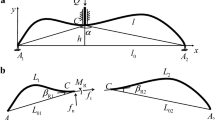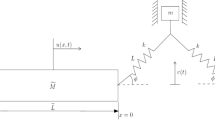Abstract
Incorporating the arc-length constraint, the dynamic relaxation strategy has been widely used to trace full equilibrium path in the post-buckling analysis of structures. This combined numerical scheme has been shown to be successful for solving snap-through problems, but its applicability to snap-back problems has been rarely investigated and remains unclear. This paper proposes a direct and more general finite-difference equation to investigate the numerical stability of this combined numerical scheme, which is dominated by the spectral radius of amplification matrix. And a key discovery of this paper is that a first minor of the tangent stiffness matrix is always negative once snap back occurs. Due to this negative minor stiffness, the spectral radius is invariably greater than one, resulting in unconditional instability, which demonstrates the invalidity of dynamic relaxation arc-length method for snap-back problems. These important conclusions are corroborated by the numerical results of three representative examples in one-, two- and three-dimensional spaces.









Similar content being viewed by others
Change history
29 October 2021
A Correction to this paper has been published: https://doi.org/10.1007/s00466-021-02108-z
Abbreviations
- \({\mathbf{\rm K}}\) :
-
Tangent stiffness matrix
- \({\mathbf{u}}\) :
-
Nodal displacement vector
- \({\mathbf{f}}\) :
-
External load vector
- \(M_{ji}\), \(M_{ii}\) :
-
First minor
- \({\mathbf{K}}^{*}\) :
-
Minor stiffness
- \({\mathbf{m}}\) :
-
Fictitious mass matrix
- \({\mathbf{c}}\) :
-
Viscous damping
- \({\mathbf{\ddot{u}}}\) :
-
Acceleration vector
- \({\dot{\mathbf{u}}}\) :
-
Velocity vector
- \(\mu\) :
-
Damping factor
- \(\Delta t\) :
-
Time increment
- \(\gamma\) :
-
Load factor
- \({\mathbf{f}}_{{{\text{ref}}}}\) :
-
Reference load vector
- \(l\) :
-
Arc radius
- \(\alpha\) :
-
Artificial scaled parameter
- \({\mathbf{A}}\), \({\mathbf{B}}\) :
-
Amplification matrix
- \({\mathbf{L}}\) :
-
Load operator
- \(\lambda\) :
-
Eigenvalue
- \({\mathbf{P}}\) :
-
Eigenvectors
- \(\rho \left( {\mathbf{A}} \right)\), \(\rho \left( {\mathbf{B}} \right)\) :
-
Spectral radius
- \({\mathbf{I}}\) :
-
Identity matrix
- \({\mathbf{I}}_{0}\) :
-
Imperfect identity matrix with a zero diagonal element
References
Riks E (1979) An incremental approach to the solution of snapping and buckling problems. Int J Solids Struct 15:529–551. https://doi.org/10.1016/0020-7683(79)90081-7
Riks E (1972) The application of Newton’s method to the problem of elastic stability. Japplmech 39:1060
Yang YB, Shieh MS (1990) Solution method for nonlinear problems with multiple critical points. AIAA J 28:2110–2116. https://doi.org/10.2514/3.10529
Yang YB, Leu LJ, Yang JP (2007) Key considerations in tracing the postbuckling response of structures with multi winding loops. Mech Adv Mater Struct 14:175–189. https://doi.org/10.1080/15376490600723578
Batoz JL, Dhatt G (1979) Incremental displacement algorithms for nonlinear problems. Int J Numer Methods Eng 14:1262–1267. https://doi.org/10.1002/nme.1620140811
Bergan PG, Horrigmoe G, Bråkeland B, Søreide TH (1978) Solution techniques for non-linear finite element problems. Int J Numer Methods Eng 12:1677–1696. https://doi.org/10.1002/nme.1620121106
Sabir AB and Lock AC (1972) The application of finite elements to the large deflection geometrically non-linear behaviour of cylindrical shells. In: Brebia CA, Tottenham H (eds) Variational methods in engineering, pp 54–65
Ramesh G, Krishnamoorthy CS (1993) Post-buckling analysis of structures by dynamic relaxation. Int J Numer Methods Eng 36:1339–1364. https://doi.org/10.1002/nme.1620360806
Ramesh G, Krishnamoorthy CS (1994) Inelastic post-buckling analysis of truss structures by dynamic relaxation method. Int J Numer Methods Eng 37:3633–3657. https://doi.org/10.1002/nme.1620372105
Siddiquee MSA, Tanaka T, Tatsuoka F (1995) Tracing the equilibrium path by dynamic relaxation in materially nonlinear problems. Int J Numer Anal Methods Geomech 19:749–767. https://doi.org/10.1002/nag.1610191102
Aberle M (1999) Kinetically damped dynamic relaxation arc-length method CUED/D-STRUCT/TR183. University of Cambridge
Zhang W, Hisada T, Noguchi H (2000) Post-buckling analysis of shell and membrane structures by dynamic relaxation method. Comput Mech 26:267–272. https://doi.org/10.1007/s004660000171
Pasqualino IP, Estefen SF (2001) A nonlinear analysis of the buckle propagation problem in deepwater pipelines. Int J Solids Struct 38:8481–8502. https://doi.org/10.1016/S0020-7683(01)00113-5
Pasqualino IP (2004) Arc-length method for explicit dynamic relaxation ICTAM
Barnes MR (1988) Form-finding and analysis of prestressed nets and membranes. Comput Struct 30:685–695. https://doi.org/10.1016/0045-7949(88)90304-5
Brew JS, Brotton DM (1971) Non-linear structural analysis by dynamic relaxation. Int J Numer Methods Eng 3:463–483. https://doi.org/10.1002/nme.1620030403
Crisfield MA (1981) A fast incremental/iterative solution procedure that handles “snap-through”. In: Noor AK, McComb HG (eds) Computational methods in nonlinear structural and solid mechanics Pergamon, pp 55–62
Crisfield MA (2012) Non-linear finite element analysis of solids and structures, vol I. Essentials Wiley
Day AS (1965) An introduction to dynamic relaxation. The Engineer 219:218–221
Teng JG, Luo YF (1998) A user-controlled arc-length method for convergence to predefined deformation states. Commun Numer Methods Eng 14:51–58. https://doi.org/10.1002/(sici)1099-0887(199801)14:1%3c51::aid-cnm130%3e3.0.co;2-l
Lee KS, Han SE, Park T (2011) A simple explicit arc-length method using the dynamic relaxation method with kinetic damping. Comput Struct 89:216–233. https://doi.org/10.1016/j.compstruc.2010.09.006
O’Brien GG, Hyman MA, Kaplan S (1950) A study of the numerical solution of partial differential equations. J Math Phys 29:223–251. https://doi.org/10.1002/sapm1950291223
Leech JW, Hsu PT, Mack EW (1965) Stability of a finite-difference method for solving matrix equations. AIAA J 3:2172–2173. https://doi.org/10.2514/3.3342
Park KC (1977) Practical aspects of numerical time integration. Comput Struct 7:343–353. https://doi.org/10.1016/0045-7949(77)90072-4
Nickel RE (1971) On the stability of approximation operators in problems of structural dynamics. Int J Solids Struct 7:301–319. https://doi.org/10.1016/0020-7683(71)90028-X
Bathe KJ, Wilson EL (1972) Stability and accuracy analysis of direct integration methods. Earthq Eng Struct Dyn 1:283–291. https://doi.org/10.1002/eqe.4290010308
Tong P (1986) An adaptive dynamic relaxation method for static problems. In: Yagawa G, Atluri SN (eds) Computational mechanics ’86. Springer, Tokyo, pp 327–339
Gholampour AA, Ghassemieh M, Karimi-Rad M (2013) A new unconditionally stable time integration method for analysis of nonlinear structural dynamics. J Appl Mech 8010(1115/1):4007682
Fung TC (1998) Complex-time-step Newmark methods with controllable numerical dissipation. Int J Numer Methods Eng 41:65–93. https://doi.org/10.1002/(sici)1097-0207(19980115)41:1%3c65::aid-nme270%3e3.0.co;2-f
Yina SH (2011) An unconditionally stable explicit method for structural dynamics. Procedia Eng 14:2519–2526
Malakiyeh MM, Shojaee S, Javaran SH (2018) Development of a direct time integration method based on Bezier curve and 5th-order Bernstein basis function. Comput Struct 194:15–31
Kolay C, Ricles JM (2019) Improved explicit integration algorithms for structural dynamic analysis with unconditional stability and controllable numerical dissipation. J Earthq Eng 23:771–792. https://doi.org/10.1080/13632469.2017.1326423
Kadapa C (2020) A simple extrapolated predictor for overcoming the starting and tracking issues in the arc-length method for nonlinear structural mechanics. Preprint arXiv:200510192v1 [csCE]
NAFEMS (1989) NAFEMS Non-linear Benchmarks Test No.NL7
Yaw LL (2009) 2D corotational beam formulation. Walla Walla University, Washington
Souza RMD (2000) Force-based finite element for large displacement inelastic analysis of frames. University of California, Berkeley
de Souza Neto EA, Feng YT (1999) On the determination of the path direction for arc-length methods in the presence of bifurcations and ‘snap-backs’’.’ Comput Methods Appl Mech Eng 179:81–89. https://doi.org/10.1016/S0045-7825(99)00042-0
Oliver J, On̄ate E (1984) A total Lagrangian formulation for the geometrically nonlinear analysis of structures using finite elements. Part I. Two-dimensional problems: shell and plate structures. Int J Numer Methods Eng 20:2253–2281. https://doi.org/10.1002/nme.1620201208
Sansour C, Bufler H (1992) An exact finite rotation shell theory, its mixed variational formulation and its finite element implementation. Int J Numer Methods Eng 34:73–115. https://doi.org/10.1002/nme.1620340107
Schweizerhof KH, Wriggers P (1986) Consistent linearization for path following methods in nonlinear fe analysis. Comput Methods Appl Mech Eng 59:261–279. https://doi.org/10.1016/0045-7825(86)90001-0
Mcleod RM (1965) Mean value theorems for vector valued functions. Proc Edinb Math Soc 14:197–209
Bogel K (1962) Uber die mehrdimensonale Differentiation. Jber Deutsch Math-Verein 65
Furi M, Martelli M (1995) A multidimensional version of Rolle’s theorem. Am Math Mon 102:243–249. https://doi.org/10.2307/2975011
Ash JM (2008) Mean value theorems for differences. Elem Math 63:122–125
Young DM (1989) A historical overview of iterative methods. Comput Phys Commun 53:1–17. https://doi.org/10.1016/0010-4655(89)90145-8
Joldes GR, Wittek A, Miller K (2009) Computation of intra-operative brain shift using dynamic relaxation. Comput Methods Appl Mech Eng 198:3313–3320. https://doi.org/10.1016/j.cma.2009.06.012
Reed WH, Lathrop KD (1970) Truncation error analysis of finite difference approximations to the transport equation. Nucl Sci Eng 41:237–248. https://doi.org/10.13182/NSE70-A20710
Mullier O, Chapoutot A, Alexandre dit Sandretto J (2018) Validated computation of the local truncation error of Runge–Kutta methods with automatic differentiation. Optim Methods Softw 33:718–728. https://doi.org/10.1080/10556788.2018.1459620
Rombouts J, Lombaert G, De Laet L, Schevenels M (2018) On the equivalence of dynamic relaxation and the Newton–Raphson method. Int J Numer Methods Eng 113:1531–1539. https://doi.org/10.1002/nme.5707
Razavi SH, Abolmaali A, Ghassemieh M (2007) A weighted residual parabolic acceleration time integration method for problems in structural dynamics. Comput Methods Appl Math 7:227–238
Lax PD, Richtmyer RD (1956) Survey of the stability of linear finite difference equations. Commun Pure Appl Math 9:267–293. https://doi.org/10.1002/cpa.3160090206
Fafard M, Massicotte B (1993) Geometrical interpretation of the arc-length method. Comput Struct 46:603–615. https://doi.org/10.1016/0045-7949(93)90389-U
Horn RA, Johnson CR (1990) Matrix analysis. Cambridge University Press, Cambridge
Chang SY (2007) Improved explicit method for structural dynamics. J Eng Mech 133:748–760
Zhang F (2005) The Schur complement and its applications. Springer, Berlin
El-Afifi MM (2004) On the recursive sequence xn+1=α+βxn+γxn−1Bxn+Cxn−1. Appl Math Comput 147:617–628. https://doi.org/10.1016/S0096-3003(02)00800-7
Johnson DE (2012) A proof of the stability of the Houbolt method. AIAA J 4:1450–1451
Acknowledgements
This research was supported in part by Jiangsu Provincial Entrepreneurship and Innovation Foundation of China (JSEI2017073), the National Natural Science Foundation of China (Grant No. 52008366), and Zhejiang Provincial Natural Science Foundation of China (Grant No. LQ21E080019).
Author information
Authors and Affiliations
Corresponding author
Additional information
Publisher's Note
Springer Nature remains neutral with regard to jurisdictional claims in published maps and institutional affiliations.
Rights and permissions
About this article
Cite this article
Zhang, P., Yang, C. A theoretical proof of the invalidity of dynamic relaxation arc-length method for snap-back problems. Comput Mech 69, 335–344 (2022). https://doi.org/10.1007/s00466-021-02071-9
Received:
Accepted:
Published:
Issue Date:
DOI: https://doi.org/10.1007/s00466-021-02071-9




